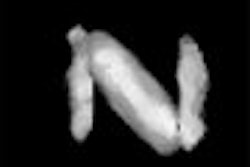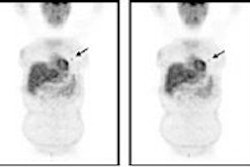BOSTON - For many imaging practitioners in the U.S., mammography is a millstone around the neck. Faced with ever-rising malpractice insurance premiums and frequent declines in reimbursement, many facilities have abandoned the procedure entirely.
"There has been an approximate 8.5% decline in facilities offering mammography each year since 2000," said Bonnie Rush, president of Breast Imaging Specialists, a San Diego-based education, consulting, and community outreach firm. "Most facilities attribute this to poor reimbursement and high malpractice insurance rates."
High insurance premiums and low reimbursement rates have not escaped the attention of radiology residents who continue their education with fellowships. According to Rush, many radiology program directors are having enormous difficulty filling openings for breast imaging fellowships.
Coupled with the decrease in offerings in mammography services and the attrition of personnel qualified to interpret them, the need for mammograms in the U.S. is increasing by approximately a million women per year. Rush offered her sobering assessment of the state of U.S. mammography practice at the American Healthcare Radiology Administrators (AHRA) meeting earlier this week.
According to Rush, the number of claims against radiologists hasn't necessarily increased, but jury awards have gotten larger. And, she said, American Medical Association statistics show that all but six states in the U.S. are either having severe problems with medical liability insurance, or are seeing signs of problems.
"Breast cancer claims precipitate the greatest number of malpractice suits in the U.S." she said. "Approximately 44% of all claims led to payment, and the average settlement was $307,000 in 2002."
Malpractice suits against breast imaging providers generally fall into one of three categories, according to Rush. These are failure to diagnose, act in a timely manner, or disclose results to the patient. Ultimately, all three areas result in a delay of treatment for the patient.
The patient’s age is also a determinant in breast imaging malpractice litigation, according to statistics from the Physicians Insurers Association of America (PIAA), Rush said. For example, women ages 20-29 represent 0.6% of breast cancer cases, but make up 6.4% of litigation. Women between the ages of 30 and 39 comprise 4.8% of the total incidence of breast cancer, but represent 24.4% of the litigants.
Patients ages 40-49 constitute 18.1% of the breast cancer population and represent 30.8% of the plaintiffs, while patients 50 and older contribute 76.5% of the breast cancer total and are 38.4% of the population who sue for malpractice, she said.
Of the patients involved in litigation, 46% reported a mass with no pain, 16% reported a painful mass, 9% said they had pain but no mass, 17% had no presenting symptoms, and in 12% of the cases symptoms were not indicated, according to Rush.
"The common misconception is that malpractice suits involve the delayed or missing diagnosis of breast cancer resulting from missing very subtle mammographic findings," noted Rush. "In fact, about 60% of the women involved in breast cancer malpractice litigation found the mass themselves."
Avoiding malpractice
"Lawsuits are not about outcomes, but about conduct," Rush said.
The ultimate decision regarding breast imaging procedures and treatment must be made by the referring physician and radiologist in light of all the circumstances presented in an individual examination, she said. Therefore, a breast imaging facility should attempt to educate its referring physicians as to the benefits and limitations of the applications of imaging techniques.
A facility should ensure that a clinical breast exam (CBE) is performed with the mammogram for breast cancer screening. When patients present for a diagnostic exam, they must be informed of why it is needed, what is expected, and about the need for follow-up.
The facility must maintain a written record of abnormal clinical results specifying the location of palpable abnormalities, and documenting in which breast and which quadrant the abnormality was located, Rush said. In addition, facilities must establish protocols to ensure that the communication loop between the radiologist, the referring physician, and the patient is closed, and that their roles are understood by all parties.
"A practice needs a protocol in place to assess if recommendations are followed, and to document if they aren't and why they aren't," she said. "This should include documentation if the patient did not return to the facility despite reminders; if the patient was physically or mentally unable to cooperate with the recommendation; and if the referring physician made an alternate decision."
Rush recommended that breast imaging centers create a mammography fact sheet that can be given to the patient by the receptionist or the mammographer, and that is then read, signed, and dated by the patient.
The fact sheet should explain that a CBE is part of the breast cancer screening process, and that a correlative breast exam is not a substitute for a CBE. In addition, it should state that a negative mammogram does not rule out malignancy in the presence of a palpable mass or other breast abnormality.
"It should also advise patients that despite the very best technologies and professional involvement, in some cases there are false-positive exams and false-negative exams," she said.
The fact sheet should also contain a statement advising the patient that a lump or clinical finding that develops after a negative mammogram should be evaluated and not delayed until the next screening exam, Rush said.
Mammographers need to create clear, concise, and non-judgmental documentation of their patient encounters.
"Write as though a lawyer is looking over your shoulder," Rush counseled. "Avoid judgmental language such as, 'the patient would not cooperate with positioning during the exam,' in favor of a statement such as, 'the patient was unable to cooperate with positioning during the exam.' Never write anything you would not want to have read in public."
According to Rush, mammographers must be able to explain why they wrote each word, why they left out certain words, and what their thought processes were as they were creating the documentation.
For the radiologists in the group, Rush recommended that the practice include the following phrase in its mission statement: "productivity is a far less important factor in the determination of income than optimal care."
"This is especially relevant if revenue is distributed according to productivity," she said.
Also, the group should consider including in department policy a reference to workload parameters for radiologists reading mammograms.
"Anywhere from 50-70 diagnostic readings a day should be indicated as the maximum," Rush advised.
Radiologists who are too tired to provide peak performance in their diagnostic interpretations should delay the interpretation or ask a colleague to fill in for them, she said. A practice may also want to consider a performance improvement plan as an indicator of quality care.
"The (American College of Radiology) suggests creating a quality assurance committee," Rush said. "A group may want to consider utilizing the medical outcomes audit as a marker and set acceptable standards and make improvements as needed."
The medical record, which is a legal document, should include patient and physician complaints, what occurred at the time of the exam, and any deviation from a normal exam. As with the mammographer's notes, clarity is necessary, Rush said. And because it is a legal document, no alteration to the record may be made. If a change needs to be entered, Rush advised creating an addendum to the record.
The record needs to include any referring physician statements, patient statements, what was seen on the image, and if the area of concern was adequately visualized. In addition, it should include what was said by the radiologist to the patient and to the referring physician.
The most important thing a radiologist reading mammograms can do to mitigate malpractice litigation is to interact with the patient and the referring physician, Rush said. This will probably mean interacting with an unhappy or angry patient at times, but the radiologist needs to appear caring and concerned -- and willing to accept responsibility wherever possible, she noted.
By establishing a rapport with both the patients and the referring physicians, a practice will find that the referring physicians are more apt to work with the radiologists and the patients will be less likely to sue, Rush said.
"I realize patient interaction goes against the grain for some radiologists, but the most common reasons for a patient not to sue is that they felt the provider listened; they felt they were adequately informed; and they felt the provider cared," she said.
By Jonathan S. BatchelorAuntMinnie.com staff writer
August 5, 2004
For a copy of the complete materials and references used in Rush's presentation, please contact her via the BIS-Breast Imaging Specialists Web site at www.mammobis.com or via email at [email protected].
Related Reading
Computer-aided detection of screening mammograms curbs false negatives, July 23, 2004
Malpractice and mammography: An exam oversold? July 15, 2004
California law shrinks malpractice payouts - study, July 13, 2004
Reports to FDA allege damage to breast implants during screening, June 15, 2004
Malpractice fears may initiate more false-positive mammograms in North America, September 16, 2003
Copyright © 2004 AuntMinnie.com



















